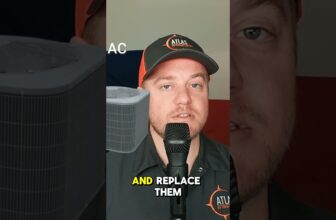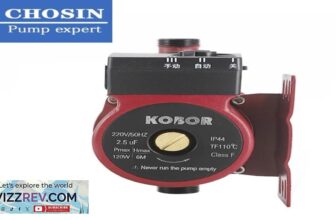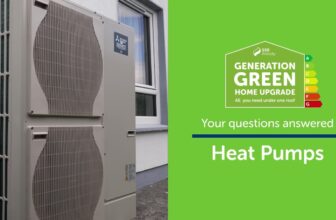How and Why to Flush Your Heating – Easy DIY
Tools Amazon affiliate links:
– DeWalt 18V Torch – https://amzn.to/42atv6K
– Knipex plier wrench – https://amzn.to/3yvYWKT
– Bahco pipe reamer – https://amzn.to/3mOckrm
How and why to flush your central heating system for DIYERs.
#diy
#plumbing
#plumber
#heating
#centralheating
that is in today's video I'm gonna be doing a Mains flush of our central heating system over time radiators rust and that rust gets into the water the central heating system which is what makes it Go Brown and over time this can cause buildup of sludge in your system pipe work the reason this is the problem is it reduces the flow rate in your pipes can also block up radiators where you've got teas and things off pipe work it can block those in the in your boiler you've got quite fine pipe work for the heat exchanger you can get stuff stuck in those too and it can end up causing pin holes in pipe work where you've got uneven flow through pipes so it's important to not let that sludge build up to stop sludge building up in your system you can see the inhibitor I've got Sentinel X100 here this is what's already in the system but the system hasn't had a full chemical and Mains flush before when I installed this unvented cylinder behind me I did do a partial Mains flush but it hasn't had a full flush with chemical Aid before that X100 inhibitor has been in the system for about 18 months so it'd be interesting to see how dirty the wall water is when it comes out so it'll show how well the inhibitor has been working the inhibitor basically Works to stop the radiators rusting I'm using this x800 chemical cleaner so the benefit of this one is it can clean your system in one hour there is a cheaper alternative which is this x400 cleaner but this one you need three to four weeks it to be in the system and you need to have your heating on regularly so that's why I'm going for the x800 the way this stuff works is it's a chemical cleaner that Scoops up the sludge and puts it in a suspension in the water so it can then be drained out and flushed out so the first step is to actually just drain the system you need to get all of that inhibitor out that's in there at the moment then I'm going to refill it with cold water and the x800 then stick it on for an hour or so stick it on high get all the radiators open get it circulating nicely and then after an hour or so drain all that out and then begin the system flush what I've done in the past is just use this filling Loop that I've got up here to flush from here so this has a main Supply to it basically open these is up and it will add to the system and then you just need to drain off open so that waste water can come out and then what you do is you go around each radiator have them all closed and just open each one individually and then let that blast through wait till the water goes clear go and do the next one first thing switch your heating off you don't want your boiler calling for heat when there's no water in the system you can see we're currently sat at exactly one bar with the system cold which in my opinion is Optimum but we're going to drain this off so this should go to zero you can just open this valve up with a spanner but one of these Universal Keys is much quicker especially in some awkward places so just get that fully open oh great color not very much pressure either but it's a bit surprising so I'm going to go and open up some of the air vents inside so I'm just going to open the bleed valve at the highest point in the house the other thing I'm going to do to help position drain off is open up all these own valves so you can just manually open them by pushing back this lever here when we fitted this we also put isolators under here so if you ever need to do any maintenance on this you can just switch this off here and then the pump side here and then you can isolate just this bit of the system rather than having to drain the whole thing down I'm just going to pop this radiator back on while the system's drain down foreign [Music] foreign just in a tiny utility room underneath the boiler so you can see we've got a drain off down there another one there and so we've got one on the both the flow and the return you can tell the return pipe is the one the left because it's got this Magna cones on it if you haven't got one of these I'd highly recommend getting one installed on your system or adding one yourself it's essentially a magnet and a filter that as the water's coming back from the radiators to the boiler the magnet just picks up and if it's a rust or Crap floating in the water we'll empty this one out and see how bad it is inside it's been about 18 months since I emptied it foreign thank you now that we've emptied the heating system it's time to put our cleaner in so I've got the x800 here one of the easiest places to put it in is the top for Tower rail where you can just take a spanner and undo the vent stick a funnel in and pour your cleaner in next job is to refill the system I'm gonna let it go up to two bar here in anticipation that I'm going to drain a lot of air out when I'm bleeding the radiators a bit of higher pressure just makes it a bit easier a bit quicker to remove air from the system I've also got these automatic air vents here which should help it bleed air from the system these are great to have for fulfilling a pressured system if you do install them though it's definitely worth putting a nice loader before them because if you ever want to pressurizer system to just air to check for leaks you want to be able to turn these off and also these do sometimes get stuck if they get crud in them so it's a lot easier to service it if you can isolate that and then just deal with this piece rather than having to drain down your entire system now all the radio sublet the pressure is still quite high in the system but I suspect there's a lot of air that as soon as the water starts moving and the pumps on it'll come out the automatic air vents or get stuck in the radiators so I'm just going to stick the heating on [Music] you see all these valves have now switched themselves on what I'm going to do is stick the pump on full try and Purge the system now that chemical cleaning has been going around for about an hour or so with the heating on full it's time to drain it out and then Mains flush and then after that refill and stick our inhibitor in the filling Loop I've got here fills onto that 15 mil copper pipe at the back which goes onto the primary return there and then considered the t's in and then it goes back to the boiler under there so the problem is if I were to just fill from The Filling Loop here only and then drain off from The Return by the boil the primary return I'm only actually going to be flushing a single piece of pipe whereas if I fill from The Filling Loop and then drain off from here this is the return so I'll still only be draining the return however if I close this lock Shield the water instead will come through this radiator from the Flow side and then drain off so that way I'll be flushing the whole system and not just the return side of the system end up pushing water through more pipe work than is ideal but it's a three bar so shouldn't be a major problem and still should flush the system out fine now when you're doing a Mains flush you want to isolate each radiator individually so close them all close all the thermostats all the lock Shields and every single one and then open one at a time so you can basically blast the water through that individual radiator now while the water is going through that individual radiator it's not a bad idea to give it a gentle tap all along and that helps to dislodge any sediment that sat in the bottom you can actually get attachments for an SDS drill which then vibrates the radiator but it's quite expensive and not great for DIY so it's a very cheap rubber mallet will do the same you just go all along giving all your radiators a good tap while they're being flushed through unfortunately it was heavy rain outside so didn't end up getting any footage of the drain off but you basically blast each radiator through until the water goes clear close it move on to the next one once all the radio's been blasted through it's now time to refill the system stick the inhibitor in and then bleed out any remaining air so I've got X100 inhibitor that I'm just going to stick into the top of this towel rail again foreign next job is to refill the system always worth having a bit of tissue handy when you're doing this just in case it sprays everywhere if you enjoyed this video please like And subscribe for more
#Flush #Heating #Easy #DIY
source











I wanted to ask if it is easy or difficult to install central heating as a beginner who has finished the 4 month school for hvac systems, where should we base ourselves
Thank you for sharing this video I appreciate your time 🙏🏻
Brilliant Vid ! Are you a plumber by trade ?
Thanks for an informative video. When you've treated with X800 for an hour on full heat, we have a drain point at one of the radiators. Should we just drain the whole system and then refill the whole system? Not sure how to 'blast' one radiator at a time – what is the sequence exactly – are you sending refill water to one radiator at a time, then draining system each time and closing off to do the next radiator, before finally refilling the whole system?
Ive just had the gas people out, theyve quoted £850 to flush my radiators 😤
I’ve got a combi boiler is the process the same by leaving the filler loop on and letting it get full whilst draining it? Do both lock-shield and trv need to be off or just the trv will be sufficient? Do you use just a normal drain off point for the water to just come out? I’ve only got one drain off point on a 15mm copper pipe by the front door will that work?
I have underfloor heating as well as numerous radiators upstairs and down. Does this complicate things when attempting a system flush?
Fantastic video thank you!
Really like this idea, I was thinking of getting one of the drain cocks open all the time and flushing the water through. Would I still need to turn off the thermostat and lock on each radiator in turn, I pressume to keep pressure up in that single radiator to remove the gunk?
Despite having the ch system flushed when a new condensing boiler was installed I still need the pump on maximum speed to reach the required circulation for the boiler to function. Do you think using the x800 would help or do I need a powerflush?
my parents used to fluish their own, but it takes hours , cheaper to hire a pro to do it IMO, time is money and the pros add in the chemicals in
10:28 i like how it has dual valves , incase one fails ,my combi boiler only has one on its refil loop which is pretty bad if it goes tits up
Do you drain the system after finishing with the cleaning solution? You didn't specify but I'm assuming you would do this before adding the inhibitor unless I'm mistaken, please let me know.
At 8:22 you talk about flushing both the flow and return as opposed to just one- is there anywhere else I can find information about this? Does this only apply to the radiator which is being used to drain down the system? This is the only bit I'm unsure about in your otherwise very informative and helpful video.
I'm dealing with a very clogged up central heating system so I want to get it cleaned up as well as possible and this seems rather relevant to flushing as effectively as possible, if you could extrapolate on this I would appreciate it- I've not seen this mentioned anywhere else. Thanks.
What the hell you got on your feet bro???
Could I just add the inhibitor directly in to the magnaclean filter since I need to clean mine off anyway? let it pump around a bit then add whatever is left?
Also, nice pipe work 🙂
Dare you to turn that pump valve off
Although i applaud you on one hand, i would NEVER advise anybody to mains flush their own heating system for various reasons, yes, you might have some money, but just how good of a job are you actually doing without knowing the full ins and out of a heating system, plus, without having somebody check your system could actually stand up to mains pressure, you could cause more problems than your solve, thus needing and engineer to repair anyway.
Like i said, informative, but not recommended
Appreciated the explanation of the different cleaning products.
X800 is not recommended unless you thoroughly flush out.
Thank you for taking the time to make and share this video! 😊
My hot water is luke warm, what could be the cauad of this?
Great video. Thanks so much.
Just confirming – when you said you were going to close the lockshield on the drain off to allow water through the radiator…did you mean open it?
Hello, could I get a bit of advice? Green star junior with 8 rads.
I have a kettling issue on the hotwater. Used fernox f3 and left it in for around four days with the boiler on for around an hour each day. Any more would make the house too hot at this time of year. I have concrete ground floor so the rads come down from above with two drain off valves. Hooked them up to hose pipes and let one drain off. One first then the other, then both. After a while, i opened the boiler mains filling loop to flush and then opened the bleed nipples to assist flow. . Did this for around an hour.
However, i didn't close the valves on the rad next to the drain off valves, so may have only flushed the return???? TBH all I really wanted was to remove the fernox to prevent any future issues, not do a great job of flushing. If some fernox f3 residue remains, it won't do any long term damage?
I have refilled, removed the air and turned the boiler on for half an hour. All rads heat up and seem hotter than before.
Should i do it again, this time with the Lockshield closed by the drain off valves? Or can i just put some fernox inhibitor and noise reducer in and hope the kettling is sorted before getting a plumber in?
Very informative and practical, thank you.
Nice to see a young chap protecting his hearing! You don’t want to suffer when you are older like I do.
What a nice system
A brilliant video, helped me a lot. Could you do a video explaining how different central heating systems work ?
Thanks, that is very informative; what spanner are you using? It seems a decent tool that makes an easy job of doing nuts.
This is brilliant, thank you for taking the time to show it. I had a question if I may please. I recently had done exactly what you did in terms if flushing the system. We also replaced a 3 radiators. However, once the system was refilled, the boiler has now started making a loud banging/juddering noise. All the radiators were bled but the noise is still there. We bled the boiler pump but that did not help. We change the automated air vent in the boiler thinking that may have been faulty. However, that did not help either. Some have said it could be the heat exchanger but I am sceptical because the boiler was absolutely fine before the work to flush the system out was done. I am at a loss. I saw in your video that at the begging you turn all the motorised valves to manual. I don't think we did that. I'm not sure if that is why but really struggling. Could it be the expansion vessel in the boiler where it may have lost its charge whilst draining? Any thoughts would be most welcome?
@4:40: Magnacunz? What is the word you're saying? Great if you could add a link in the description.
That spanner looks like terminators hand 😅
So in general this is a fairly safe DIY method for someone to do at home?
only came to see the drainoff and its not there 😛 dislike button hit
Nice zoned system .. looks great.. better than most plumbers install
Good video!!
How much x800 and x100 do you use? Do you just put full tub in?
Could this possibly help if there is a blockage in the heat exchanger?
Can this be done by pouring x800 into the magna clean filter and draining via the magna clean filter an hour after?
Just realised from one of your comments that you're not in the trades and just a DIYer! Probably the most knowledgeable DIYer I've seen!! I have a few questions which may seem silly, so when you initially drain the system before adding x800 can you drain from any radiator? Would it be better to drain from one downstairs? And when it comes to flushing are you draining every radiator individually while the mains water is running and then moving to the next or is the draining occurring at only 1 radiator while you open each radiator one by one?
Although Iv done this job before i thought id ask the service engineer for a price for him to do it as I couldn’t be bothered but after a straight up quote of £200 I instantly decided to stop being lazy and I’m doing it myself at the week 👍 thankyou for the video mate.
This guy totally blue-balled us on missing recording flushing the radiators through. It’s why we’re all here my dude
If you are closing the lockshields you will need to re-balance the system?
I recently added 1L of inhibitor to by unvented system (very similar to this one) via the heated towel rail in the bathroom. I've also just read that the whole system should be drained if the system is pressurised before doing this (which it wasn't). Any advice or problems I may face? All rads have been turned back on and bled. All work, no leaks, pressure is just over 1.2bar as it was before.